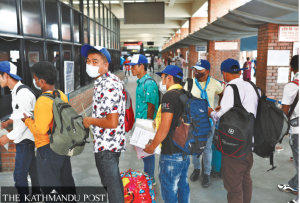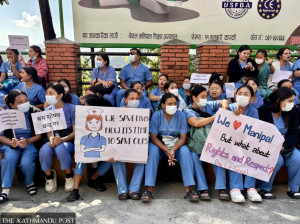Editorial
Many patients, little patience
Clinical laboratories must be regulated
Drained of blood and patience, Shree Krishna Dhungana, a 44-year-old patient at Shahid Gangalal National Heart Centre with a 2.7 mm hole in his heart, was recently told that his much-needed scheduled heart surgery may not occur as planned. The hospital’s reason for the delay is far from positive. Well, at least in one report. Despite taking three blood grouping tests, the hospital’s laboratory presented two contradicting results about his blood group. In one, he is A negative. In the other, A positive.
The laboratory’s inability to confirm his blood group is unfortunately far from unusual. Across the country, inconsistent lab reports have resulted in misdiagnoses, further health complications, delayed medical interventions, and even avoidable deaths. According to Dr Harischandra Upreti, director at the National Public Health Laboratory, countless people with inconsistent test results from various labs across the country have visited the laboratory seeking clarification and authenticity.
The growing emergence of ‘kickbacks’ in Nepal’s healthcare industry has only exacerbated the situation.The kickbacks operate through a vicious cycle: Doctors order expensive tests (regardless of whether or not they are clinically required), unregulated laboratories produce inconsistent results and further tests are requested for ‘clarification purposes’. For patients who are compelled to travel from remote villages to urban centres simply for check-ups and tests, misdiagnoses can hold destructive financial consequences. The cycle—which has been draining patients of time, energy, money and bodily fluids—has only made healthcare in the country increasingly unaffordable and inaccessible.
The prevalent practice—yet another symptom of the country’s acute case of governmental apathy—has been enabled by the prevailing lack of regulation in the medical industry. The much overdue need for a government agency to regulate the quality of reagents, shut down illegally-operating laboratories, and quality-check those that are registered cannot be overstated. The National Public Health Laboratory estimates that only around 1,500 laboratories are registered in the country. Hundreds others operate illegally. Medical practitioners and lab professionals across the country have pointed to models like the US Clinical Laboratory Improvement Amendments, which has produced regulatory bodies that conduct regular on-site surveys and examinations.
Granted, the call for a regulatory mechanism for laboratories has been made throughout the years. In 2015, the Commission for the Investigation of Abuse of Authority directed the Ministry of Health and Population to regulate price and service disparities in many diagnostic tests conducted by health facilities across the country. Noting the lack of a clear policy or regulatory mechanism on medical equipment and supplies—which invariably affects the authenticity of reports and quality of services—a meeting was held with various stakeholders. No productive response followed.
The continued lack of regulation will simply lead to a gloomy prognosis for this increasingly privatised medical sector: rocketing prices, substandard care, and a continued onslaught of inconsistent results and diagnoses. While the government may be immune to substandard quality, patients of all backgrounds deserve much better. Patience is wearing thin.




 18.12°C Kathmandu
18.12°C Kathmandu














